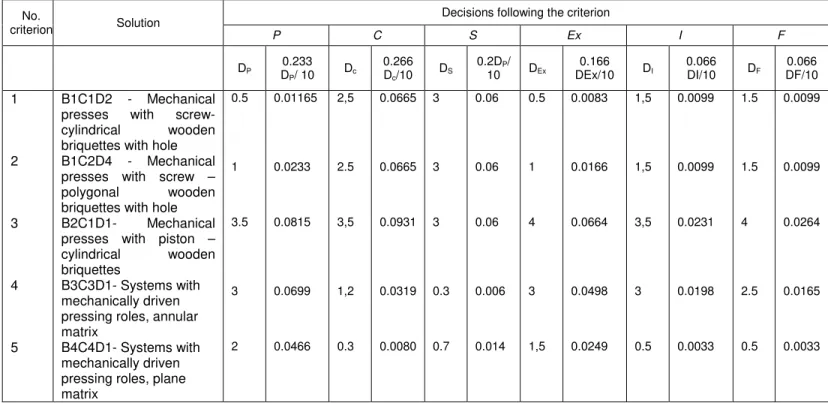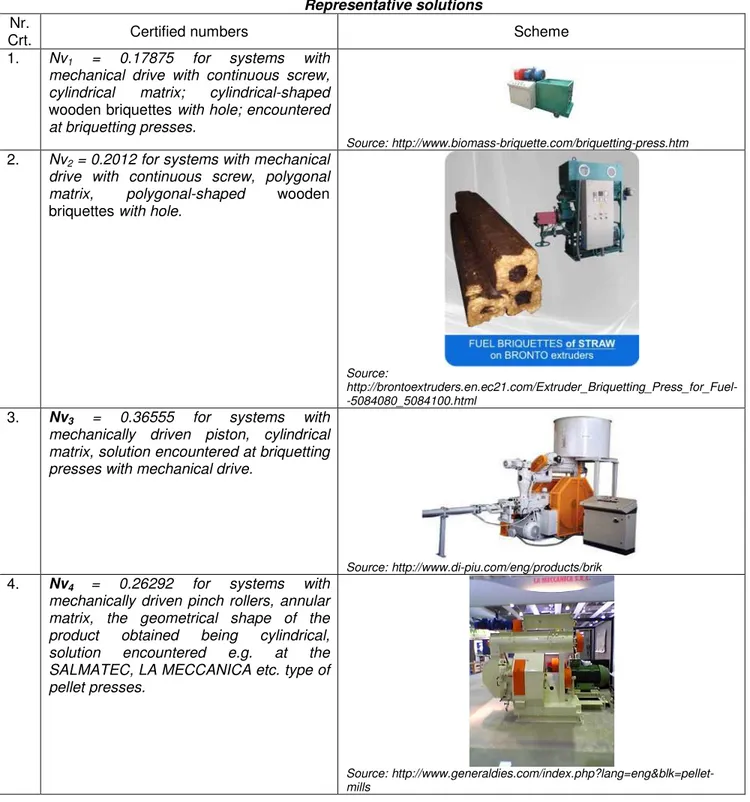61
APPLICATION OF THE GENERALISED OBJECT MODEL FOR THE TECHNICAL
CREATION RELATED TO THE PRODUCTION OF WOODEN BRIQUETTES AND
PELLETS
Mihai OLAN
Eng.PhD. - S.C. Q S.R.L. Iasi, România E-mail: vibrobloc@yahoo.com
Dumitru CUCIUREANU Eng. - S.C. Q S.R.L. Iasi, România
E-mail: office@qsrl.ro
Abstract:
The present paper describes the usage of the generalised object model for the analysis of the production processes of biofuels from wooden biomass. The “imposed decision” technique is employed to analyse several alternative solutions in order to find out the optimum one, to be further developed and put into practice.
Key words: biofuels; wooden briquettes; wooden pellets; biomass.
INTRODUCTION
Biomass is a common name for dead organic material, mostly from vegetable origin which a person can use for generating energy, except fossil matters such as oil and coal (https://www.zel-en.si/en/wooden-biomass.html). Wood, straw, fast-growing crops, organic waste can be included in this category and used directly for burning where thermal and/or electric energy is created.
The biomass is considered as being the key to the renewable resources of the future, not only at small scale. It already substitutes 14 % of the world main energy consumption (Krauss and Szymański 1988, Olan 2009). The usage of the biomass energy has many qualities which provide benefits to the environment, including attenuating the climatic changes.
During the last couple of years, the developed countries in Europe have shifted to intense exploitation programs involving this inexhaustible reservoir of bio-regenerating and clean energy, and the results are tailored accordingly.
Romania has a huge volume of second generation fresh biomass which is not used (Fig.1). During this period, many installations for briquetting or pelleting were imported from specialised companies in Europe or China, while Romania has only a few producers in this field.
Fig. 1.
Biomass potential in Romania
62
The most important ways of valorising wood as biofuel are pelleting and briquetting.
Wood pellets are small cylinders (6mm diameter and 3-40 mm length). They are generally made from sawdust resulting from the mechanical processing of timberand they are formed by forcing the sawdust through a rotating press, with a pair of pressing rollers, reaching a compacting ratio larger than 3:1.
The briquettes are larger (5 to 8cm diameter and a 10 to 30cm length). They are obtained by mechanical or hydraulic pressing.
METHOD OF THE GENERALISED OBJECT
In the present article, an example of applying the generalised object method is given, with the aim of finding some optimal solutions for the manufacturing of wooden briquettes and pellets. The imposed decision technique allows analysing the known solutions, but also finding some new viable solutions, resulting from the combination of the existing ones, which can be then further developed in future projects.
Establishing the formatting assemblies
Formatting assemblies are established by selecting several classification criteria. For the briquetting process, these can be:
B - according to the type of activating the installation:
B1 - mechanical activation systems with continuous screw; B2 - mechanical activation systems with piston;
B3 - systems with hydraulic activation; B4 - systems with pinch rollers; B5 – other.
C - according to the constructive and functional solution of obtaining the pressing procedure: C1 - forming the wooden briquette within the interior of the cylindrical matrix;
C2 - forming the wooden briquette within the interior of the polygonal matrix C3 - forming the wooden pellets within the openings of the annular matrix; C4 - forming the wooden pellets in the openings of the planar matrix; C5 – other.
D – according to the geometric shape of the product obtained: D1 - cylindrical;
D2 - cylindrical with hole;
D3 - polygonal (square or hexagonal section); D4 - polygonal with hole;
D5 – other.
Elaborating the generalised object model of the technical creation
The generalised object of the technical creation is presented under the form of a cylindrical and morphologic matrix, as given in Fig. 2. Each sector (triple assembly BiCjDk) represents a solution, the total number of solutions being: N = 4 x 4 x 4= 64. Some are known, and some are new. The incompatible ones will be eliminated, and the other will have to be analysed since, following their complete settlement, they can lead to highly efficient constructions. In order to eliminate the incompatibles solutions, one can proceed to approach the analysis on sub-morphologies, making a sequential and selective morphologic research (Belous and Plahteanu 2005).
Level
[ B1C1D1 ] 3
[ B1C1D2 ] { B1C2D1} 4
{B1C1D3 } {B1C2D2} {B1C3D1} 5
{B1C1D4} {B1C2D3} {B1C3D2} (B1C4D1) 6
{B1C3D3} {B1C4D2} [B1C2D4] [B2C2D3] {B2C1D4} {B2C3D2} (B2C4D1) 7 {B1C3D4} (B1C4D3) {B2C3D3} {B2C4D2} (B2C2D4) {B3C1D4} {B3C2D3} {B3C3D2} 4C1D3) (B4C2D2) (B4C3D1)
8
63 {B4C3D2} [B4C4D1]
{B2C4D4} {B3C3D4} (B3C4D3) (B4C3D3) {B4C2D4} {B4C4D2} 10
{B3C4D4} (B4C4D3) { B4C3D4} 11
{B4C4D4} 12
Known solutions: [ ] Unknown solutions: ( ) Incompatible solutions: { }
Fig. 2.
Matrix of the generalised object model.
RESULTS AND DISCUSSION
64
For the evaluation of the existing variances, the “imposed decision” technique is used, taking into consideration the following main appreciation criteria:
productivity (P) and investment costs (C);
constructive, functional and technological simplicity (S);
exploitation commodity (Ex);
cost of living (ease of repair and spare parts) (I);
human factor (worker’s qualification etc.) (F).
The criteria denoted by P, C, S, Ex, I and F are compared among themselves two by two, obtaining decisions under the form of 1-0; 0.5-0.5 or 0-1. Their number is given by the relation:
D = C2e = 6 (6-1)/2 = 15 decisions (1)
By dividing the number of positive decisions N to the total number of decisions D, the importance coefficient of each criterion is obtained, which leads to their re-ordering according to Table 1. Out of the nine solutions studied, the most representative ones are the following:
B1C1D2 - systems with mechanical drive and continuous screw, forming the wooden briquette in the interior of the cylindrical matrix; geometrical shape of the product obtained is cylindrical with hole; as encountered at briquetting presses;
B1C2D4 - systems with mechanical drive with continuous screw, forming the wooden briquette in the interior of the polygonal matrix, the geometrical shape of the product obtained is polygonal with hole; as encountered at briquetting presses;
B2C1D1 - systems with mechanically driven piston, forming the wooden briquette within the interior of the cylindrical matrix, the geometrical shape of the product obtained is cylindrical; solution encountered at briquetting presses with mechanical activation;
B3C3D1 - systems with mechanically driven pressing rollers, forming the wooden pellets in the holes of the annular matrix; the geometric shape of the product obtained is cylindrical; solution encountered at the SALMATEC, LA MECCANICA etc. pellet presses;
B4C4D1 - systems with mechanically driven rollers, forming the wooden pellets in the holes of the plane matrix; the geometrical form of the product obtained is cylindrical; solutions encountered at the KAHLE type pellet presses.
Table 1
Criteria for the analysis by using the “imposed decision” method
No.
crt. Criterion 1 2 3 4 5 6 7 8 9 10 11 12 13 14 15
Total positive decision
Importance coefficient
N12
1 P 1 0 1 0.5 1 3,5 0.233
2 C 0 1 1 1 1 4 0.266
3 S 1 0 0.5 1 0.5 3 0.2
4 Ex 0 0 0.5 1 1 2.5 0.166
5 I 0.5 0 0 0 0.5 1 0.066
6 F 0 0 0.5 0 0.5 1 0.066
65
Table 2
Selected solutions
No.
criterion Solution
Decisions following the criterion
P C S Ex I F
DP 0.233
DP/ 10 Dc
0.266 Dc/10 DS
0.2DP/
10 DEx 0.166
DEx/10 DI 0.066
DI/10 DF 0.066
DF/10 1 2 3 4 5
B1C1D2 - Mechanical presses with screw- cylindrical wooden briquettes with hole
B1C2D4 - Mechanical presses with screw – polygonal wooden briquettes with hole
B2C1D1- Mechanical
presses with piston – cylindrical wooden briquettes
B3C3D1- Systems with mechanically driven pressing roles, annular matrix
B4C4D1- Systems with mechanically driven pressing roles, plane matrix 0.5 1 3.5 3 2 0.01165 0.0233 0.0815 0.0699 0.0466 2,5 2.5 3,5 1,2 0.3 0.0665 0.0665 0.0931 0.0319 0.0080 3 3 3 0.3 0.7 0.06 0.06 0.06 0.006 0.014 0.5 1 4 3 1,5 0.0083 0.0166 0.0664 0.0498 0.0249 1,5 1,5 3,5 3 0.5 0.0099 0.0099 0.0231 0.0198 0.0033 1.5 1.5 4 2.5 0.5 0.0099 0.0099 0.0264 0.0165 0.0033 Table 3
Weighting of the importance coefficients
No. Criterion Importance coefficient
1 Productivity, P 0.233
2 Investment costs, C 0.266
3 Constructive, functional and technological
simplicity, S 0.2
4 Exploitation commodity, Ex 0.166
5 Cost of living, I 0.066
6 Human factor, F 0.066
Then the certified numbers for each solution are calculated, according to Equation (2):
Nv = (0.233DP + 0.266DC + 0.2DS + 0.116DEx + 0.166DI + 0.066DF) /10 (2)
According to this equation, the certified numbers of the five solutions are as follows:
Nv1 = (0.233 x 0.5 + 0.266 x 2,5 + 0.2 x 3 + 0.116 x 0.5 + 0.166 x 1,5 + 0.066 x 1,5)/10 = 0.17875
Nv2 = (0.233 x 1 + 0.266 x 2,5 + 0.2x3 + 0.116 x 1 + 0.166 x 1,5 + 0.066 x 1,5)/10 = 0.2012 Nv3 = (0.233 x 3,5 + 0.266 x 3,5 + 0.2 x 3 + 0.116 x 4 + 0.166 x 3,5 + 0.066 x 4)/10 = 0.36555
Nv4= (0.233 x 3 + 0.266 x 1,2 + 0.2 x 0.3 + 0.116 x 3 + 0.166 x 3 + 0.066 x 2,5)/10 = 0.26292
66 Thus, representative are:
Nv3 for the systems with mechanically driven piston, forming the wooden briquette within the cylindrical
matrix; the geometric shape of the product obtained being cylindrical; solution encountered e.g. at the DI-PIU type briquetting presses (Table 4);
Nv4 for systems with mechanically driven pressing roles, forming the wooden pellets in the holes of the
annular matrix, the geometric shape of the product obtained being cylindrical; solution encountered at e.g. SALMATEC, LA MECCANICA presses (Table 4).
Table 4
Representative solutions Nr.
Crt. Certified numbers Scheme
1. Nv1 = 0.17875 for systems with
mechanical drive with continuous screw, cylindrical matrix; cylindrical-shaped
wooden briquettes with hole; encountered at briquetting presses.
Source:http://www.biomass-briquette.com/briquetting-press.htm 2. Nv2 = 0.2012 for systems with mechanical
drive with continuous screw, polygonal matrix, polygonal-shaped wooden briquettes with hole.
Source:
http://brontoextruders.en.ec21.com/Extruder_Briquetting_Press_for_Fuel--5084080_5084100.html
3. Nv3 = 0.36555 for systems with
mechanically driven piston, cylindrical matrix, solution encountered at briquetting presses with mechanical drive.
Source:http://www.di-piu.com/eng/products/brik 4. Nv4 = 0.26292 for systems with
mechanically driven pinch rollers, annular matrix, the geometrical shape of the product obtained being cylindrical, solution encountered e.g. at the SALMATEC, LA MECCANICA etc. type of pellet presses.
67 5. Nv5 = 0.09758 for systems with
mechanically driven pinch rollers, plane matrix, geometrical shape of the product obtained being cylindrical; solution encountered e.g. at the KAHLE type pellet presses.
Source:
https://www.svebio.se/sites/default/files/wache_sebastian_NBB15.pdf
Restraining the objective of the technical creation
The following conclusions can be developed regarding the technical creation orientation in the field of equipment concept and design for the wooden pellets production lines:
a. creation of new equipment, at lower manufacturing costs and higher work productivity; b. creation of new equipment, at much lower investment costs.
CONCLUSIONS
For the increase of competition, it is necessary to undertake some research within a multidisciplinary group in order to put into practice the alternative solutions revealed as feasible by the present analysis:
manufacturing an equipment for the production of wooden pellets with reduced electricity consumption, using the capital of physical effects in the creativity field for the biomass plasticisation;
using a mechanical pre-compression system with continuous screw for the preparation of the raw material prior to pelleting.
Manufacturing a new, innovative model of pelleting installation would be the end-outcome of this research.
REFERENCES
Belous V, Plahteanu B (2005) Fundamentele creatiei tehnice, Editura Performantica, Iasi, 2005. http://www.zel-en.si/en/wooden-biomass.html
http://www.biomass-briquette.com/briquetting-press.htm
http://brontoextruders.en.ec21.com/Extruder_Briquetting_Press_for_Fuel--5084080_5084100.html
http://www.di-piu.com/eng/products/brik
http://www.generaldies.com/index.php?lang=eng&blk=pellet-mills
https://www.svebio.se/sites/default/files/wache_sebastian_NBB15.pdf
Krauss A, Szymański W (1988) Briquetting of lignocelulose waste in perpetual screw briquetting machine. Department of Woodworking Machinery and Fundamentals of Machine Construction, The August Cieszkowki Agricultural University of Poznan, Poland.


